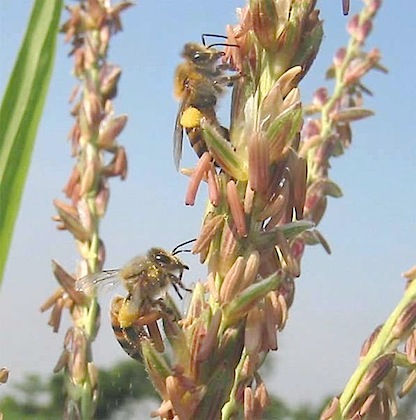by Linda Bonvie
January 23, 2013

While alarm bells are being sounded by scientists abroad about the threat posed to honeybees from three systemic pesticides, the U.S. Environmental Protection Agency may be about to give a green light to the registration of a new, very similar chemical.
Last week the European Food Safety Authority (EFSA) released its report on certain pesticides and bees, finding that three of the neonicotinoid chemicals (the subject of last weeks blog) used widely on crops pose an “acute risk” to honeybees.
The EFSA findings could potentially be the tipping point leading to a ban on several of these systemic, synthetic nicotine chemicals in the European Union, something that environmental groups, beekeepers, and concerned individuals in the U.S. had hoped for with the filing of an emergency petition to stop the use of Clothianidin (one of the neonicotinoids) at the EPA last year.
While the EPA denied that petition to immediately suspend the chemical’s registration, it did open the docket for public comment for a limited time last summer. According to Beyond Pesticides, one of the groups that filed the document with the agency, there were over one million signatures supporting it, with well over a thousand posted at the EPA docket online.
EFSA, a non-regulatory risk assessment agency for the European Union, identified numerous threats to bees by three of the neonicotinoids, including those of exposure from pollen, nectar, dust from the pesticides and guttation, which are drops of sap that form on the tips of a leaf that bees forage from.
HFCS may be conduit for toxins
Another form of exposure to these synthetic nicotine chemicals that Food Identity Theft reported on last week may come from the high fructose corn syrup fed to honeybees, as practically all corn, with the exception of organic, comes from seed treated with the neonicotinoids. According to the EPA, corn seed treatment is the single biggest use for these chemicals, with corn also being the crop most widely grown in North America “in nearly every state…reaching a near-record 92 million acres in 2011,” says the agency, comparing that to an “area virtually equivalent to the entire country of Germany.”
Because these pesticides act in the plant systemically, they stay active as a plant grows, causing contamination of the pollen and nectar, and potentially any products made from seed-treated crops.
“Given the vulnerability of bees when HFCS is typically used as a supplemental feed, and the fact that the bee’s immune systems are likely weakened, ongoing diligence is required in monitoring HFCS for very low levels of pesticides,” Washington State University Research Professor Dr. Charles Benbrook told me in an email.
The plight of the honeybees known as colony collapse disorder (CCD), where honeybees abandon their hive and queen, was first recognized around 2006 and coincides with the registration of neonicotinoid pesticides and also with extra high-dose treatments of corn seed for several years beginning around 2004.
In denying the environmental group’s 2012 petition, the EPA admits that “data, literature and incident reports do make clear that Clothianidin is acutely toxic to bees.” And a leaked 2010 memo from the agency clearly states, “The persistence of residues and potential residual toxicity of Clothianidin in nectar and pollen suggests the possibility of chronic toxic risk to honey bee larvae and the eventual instability of the hive.” Despite these admissions, the chemical is still on the market.
While the neonicotinoids may be under close scrutiny in Europe, here in the United States the EPA is on the verge of granting a new pesticide registration for a similar chemical called sulfoxaflor, referred to as “a fourth-generation neonicotinoid,” to be used on a wide variety of crops from nuts to citrus to cotton (the EPA will have a public comment period open until February 12th).
What effect yet more of these systemic pesticides will have on honeybees already in trouble is a gamble the EPA appears to be poised to take. Many others, however, don’t want to wager for such high stakes. As one consumer stated in a public comment to the agency: “Do not continue to allow toxins into the environment that harm such valuable insects. NO HONEYBEES = NO FOOD.






Leave a comment